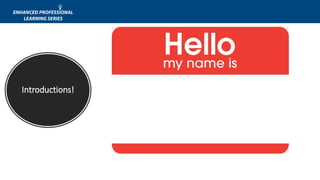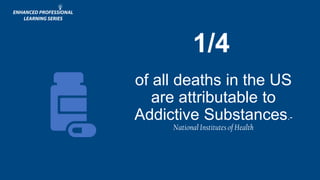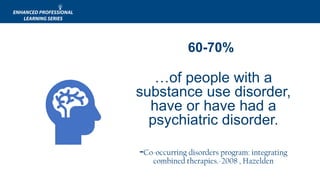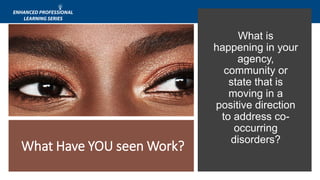Region 8 Co-Occurring Disorders (Wk 1)
- 1. Christina Boyd, LSCSW, LCAC Co-Occurring Disorders EPL
- 2. Week #1 Overview of Series and Co-Occurring Disorders
- 3. • Overview of Workwise Series • IntroductionsWelcome • Need for this Knowledge • Overview of Co-Occurring DisordersPresentation • Preview of next week • Assign Learning Activity • Questions Summary Agenda
- 4. Workwise is an online learning series that provides interactive training and consultation to professionals delivering behavioral health services on topics essential to increasing knowledge, building skills, and changing practice through the adoption of evidence-based and promising practices. Workwise uses: Virtual interactive training through real-time skill- based learning and practice Group and self- study activities Reading assignments Discussions Workwise
- 5. Week Agenda/Topic Assignments DATE Orientation to Technology Session COMPLETED! One Welcome/Overview of Workwise Series and of Co- Occurring Disorders 6/1/19 Two Overview of DEPRESSIVE Disorders 6/12/19 Three A Closer Look at ANXIETY Disorders and TRAUMA 6/19/19 Four Starting to understand PERSONALITY Disorders 6/29/19 Five Integration of BH into SUD treatment 7/3/19 Six Cultural Intelligence and Wrap up 7/101/19 Co-Occurring DO Series
- 7. How will this knowledge benefit the people that I am here to help? Something to Ponder…
- 8. Have you heard of Integration? Where are we headed??
- 9. The coexistence of both a mental health and a substance use disorder is referred to as a Co-Occurring Disorder. Co-Occurring Disorders
- 10. Among the 20.2 million adults in the U.S. who experienced a substance use disorder, 50.5%—10.2 million adults—had a co- occurring mental illness, according to Results from the 2014 National Survey on Drug Use and Health: Mental Health Findings, NSDUH Series published by Substance Abuse and Mental Health Services Administration (SAMHSA). (Center 2015) Co-Occurring Stats
- 11. Why are we looking at all of this?
- 12. • New information related to Special Populations: • Older adults • Parents with children • Those working in safety sensitive occupations • Criminal justice settings • AS WELL AS: “Incorporation of the latest understanding of Co-Occurring Disorders Capability”What’s New in ASAM Criteria?
- 13. • Are there current psychiatric illnesses or psychological, behavioral, emotional or cognitive problems that need to be addressed? • Are there chronic conditions that affect treatment such as bipolar or anxiety? • Do any emotional, behavioral, or cognitive signs or symptoms appear to be an expected part of the addictive disorder? EMOTIONAL, BEHAVIORAL, OR COGNITIVE CONDITIONS AND COMPLICATIONS Dimension 3
- 14. • Are they severe enough to warrant specific mental health treatment, even if symptoms are caused by substance use? • Is the patient able to manage the activities of daily living? • Can he or she cope with any emotional, behavioral or cognitive problems? ASAM-Dimension 3 Continued
- 15. • Dangerousness/Lethality • Interference with Addiction Recovery Efforts • Social Functioning • Ability for Self-Care • Course of Illness Dimension 3 Risk Domains
- 16. • Is the patient in immediate danger of continued severe mental health distress and/or alcohol, tobacco and/or drug use? • Does the patient have any recognition or understanding of, or skills in coping with his or her addictive, co-occurring, or mental disorder? • Have addiction and/or psychotropic medications assisted in recovery before? • What are the person’s skills in coping with protracted withdrawal, cravings, or impulses? RELAPSE, CONTINUED USE OR CONTINUED PROBLEM POTENTIAL Dimension 5
- 17. • How well can the patient cope with negative effects, peer pressure, and stress without recurrence of addictive thinking and behavior? • How severe are the problems and further distress that may continue or reappear if the patient is not successfully engaged in treatment? • How aware is the patient of relapse triggers and skills to control addiction impulses or impulses to harm self or others? Dimension 5 Continued
- 18. What do you think? Can we ignore these domains?
- 19. of all deaths in the US are attributable to Addictive Substances.- National Institutes of Health 1/4
- 20. …of people with a substance use disorder, have or have had a psychiatric disorder. -Co-occurring disorders program: integrating combined therapies.-2008 , Hazelden 60-70%
- 21. …of adults with a Mental Illness also have a chronic health condition -National Council for Behavioral Health-2013 68%
- 22. Individuals with addiction and co- occurring mental illness die, on average, 37 years earlier than Americans without severe addictions and mental health problems. (Oregon, 2008) 37 Years…
- 23. Public program leaders, health professionals, advocates and stakeholders continue to be concerned with the disproportionately high loss of life of those with substance use and/or mental health disorders. Efforts are under way to reduce observed disparities in mortality. Initial interventions to modify behavioral and other risks have increased life expectancy by up to five years. (Wright, et. All, 1998) …increased Life Expectancy by up to 5 years…
- 24. According to SAMHSA, the most effective dual diagnosis regimen treats both the mental illness and substance issues at the same time. (SAMHSA 2009) Treatment needs to go hand in hand…
- 25. What do we do?
- 26. What are your Challenges? What do you want to learn or what would be helpful for you during this series?
- 27. • 47 Years Old • Involvement in the legal system • Had children involved in Child Protection Services in the past • Diagnosed with Diabetes • No Primary Care Physician • Goes to the ER for medical care • Has had treatment in the past (MH/SUD/Inpatient and Outpatient) • Works as a receptionist currently and had multiple jobs in the past 10 years • No Insurance • Currently no transportationMEET MOLLY Accessing care for opioid use
- 28. What Have YOU seen Work? What is happening in your agency, community or state that is moving in a positive direction to address co- occurring disorders?
- 29. Depression Mood Disorders (Bi-Polar DO) Anxiety and Trauma Personality Disorders Suicide Prevention OTHER DISORDERS OF NOTE: ADHD Schizophrenia and other Psychotic DO LEARN MORE! Common Mental Health Conditions and Issues we will be discussing in this series:
- 33. https://www.nami.org/NAMI/media/NAMI- Media/Infographics/GeneralMHFacts.pdf Some more stats in Infograph form…
- 36. A look at Depression and other Mood DisordersSneak Peek at next week ….
- 37. Read the Article “Co-Occurring substance use and mental disorders among adults with opioid use disorder” - Consider Questions to Discuss Next Week. Learning Activity-Week #1
- 38. Questions
- 39. • Center for Behavioral Health Statistics and Quality. (2015). Behavioral health trends in the United States: Results from the 2014 National Survey on Drug Use and Health (HHS Publication No. SMA 15-4927, NSDUH Series H-50). Retrieved from http://www.samhsa.gov/ data/ • http://www.integration.samhsa.gov/integrated-care-models/integration-infographic • http://www.drugabuse.gov/related-topics/medical-consequences-drug-abuse/mortality • http://www.thenationalcouncil.org/topics/addictions • http://www.integration.samhsa.gov/integrated-care-models/integration-infographic • https://www.nami.org/NAMI/media/NAMI-Media/Infographics/GeneralMHFacts.pdf • The ASAM Criteria, Treatment Criteria for Addictive, Substance-Related, and Co-Occurring Conditions, Third Edition, 2013. • Oregon Department of Human Services Addiction and Mental Health Division. Measuring premature mortality among Oregonians. June 2008. • Strosahl, 1998; Fries, et. al., 1993; Shapiro, et. al., 1985 • Substance Abuse and Mental Health Services Administration. Integrated Treatment for Co-Occurring Disorders: The Evidence. DHHS Pub. No. SMA-08-4366, Rockville, MD: Center for Mental Health Services, Substance Abuse and Mental Health Services Administration, U.S. Department of Health and Human Services, 2009. • Wright, Janice C. and Weinstein, Milton C. Gains in Life Expectancy from Medical Interventions – Standardizing Data on Outcomes. The New England Journal of Medicine, 339(6):380-386, August 6, 1998. References:






































